Secure Communication and Dynamic Formation Control of Intelligent Drone Swarms Using Blockchain Technology
Abstract
1. Introduction
- Distributed Architecture: The decentralized communication framework inherently adapts to large-scale distributed networks, where nodes propagate block updates via P2P broadcasting, eliminating frequent requests to a central controller [3].
- Data Integrity Assurance: When drones perform tasks, they need to collect and transmit a large amount of data. The hash chain storage structure of the blockchain ensures the integrity of the data during transmission and storage, preventing malicious tampering and forgery [4].
- Smart Contract Autonomy: Smart contracts are automated execution protocols on the blockchain that can automatically trigger corresponding operations when preset conditions are met. In drone clusters, the introduction of smart contracts can achieve autonomous collaboration and task allocation, reduce human intervention, and improve task execution efficiency.
- (1)
- We proposed a blockchain event-driven distributed UAV formation control architecture, which utilizes smart contracts to achieve autonomous UAV registration, task distribution, and formation management. By leveraging the event broadcasting mechanisms, follower UAVs can monitor and respond to formation commands in real-time, effectively addressing the large-scale communication bottleneck issues inherent in traditional control architectures.
- (2)
- We designed a parametric dynamic formation control algorithm with a conflict resolution mechanism, introducing a mathematical model based on angle–distance dual parameter sets that supports adaptive switching among different formations. The algorithm incorporates Haversine spherical coordinate transformation for large-scale precise positioning and implements a blockchain-based position conflict resolution mechanism, ensuring collision-free formation reconfiguration through Euclidean distance calculation and on-chain position locking.
- (3)
- We established the first integrated blockchain–flight control simulation verification platform and completed scalability validation. The platform combines Ganache blockchain, PX4 flight control, and Gazebo physics engine to achieve full-process simulation from command issuance to physical execution.
2. Related Work
2.1. Formation Control
2.2. Blockchain
3. Model Architecture
3.1. Smart Contract
3.2. Leader–Follower Architecture
4. Methods
4.1. Smart Contract
4.2. Dynamic Formation Control
| Algorithm 1 Generate candidate positions |
|
4.3. Simulation Environment
5. Results
6. Conclusions
Author Contributions
Funding
Institutional Review Board Statement
Informed Consent Statement
Data Availability Statement
Acknowledgments
Conflicts of Interest
References
- Reynolds, C.W. Flocks, herds and schools: A distributed behavioral model. In Proceedings of the 14th Annual Conference on Computer Graphics and Interactive Techniques, Anaheim, CA, USA, 27–31 July 1987; pp. 25–34. [Google Scholar]
- Do, H.T.; Hua, H.T.; Nguyen, M.T.; Nguyen, C.V.; Nguyen, H.T.; Nguyen, H.T.; Nguyen, N.T. Formation Control Algorithms for Multiple-UAVs: A Comprehensive Survey. EAI Endorsed Trans. Ind. Networks Intell. Syst. 2021, 8, e3. [Google Scholar] [CrossRef]
- Jensen, I.J.; Selvaraj, D.F.; Ranganathan, P. Blockchain technology for networked swarms of unmanned aerial vehicles (UAVs). In Proceedings of the 2019 IEEE 20th International Symposium on“ A World of Wireless, Mobile and Multimedia Networks” (WoWMoM), Washington, DC, USA, 10–12 June 2019; IEEE: Piscataway, NJ, USA, 2019; pp. 1–7. [Google Scholar]
- Lei, K.; Zhang, Q.; Lou, J.; Bai, B.; Xu, K. Securing ICN-based UAV ad hoc networks with blockchain. IEEE Commun. Mag. 2019, 57, 26–32. [Google Scholar] [CrossRef]
- Roldão, V.; Cunha, R.; Cabecinhas, D.; Silvestre, C.; Oliveira, P. A leader-following trajectory generator with application to quadrotor formation flight. Robot. Auton. Syst. 2014, 62, 1597–1609. [Google Scholar] [CrossRef]
- Zhang, J.; Yan, J.; Zhang, P. Multi-UAV formation control based on a novel back-stepping approach. IEEE Trans. Veh. Technol. 2020, 69, 2437–2448. [Google Scholar] [CrossRef]
- Ghamry, K.A.; Zhang, Y. Formation control of multiple quadrotors based on leader-follower method. In Proceedings of the 2015 International Conference on Unmanned Aircraft Systems (ICUAS), Denver, CO, USA, 9–12 June 2015; IEEE: Piscataway, NJ, USA, 2015; pp. 1037–1042. [Google Scholar]
- Yang, K.; Dong, W.; Tong, Y.; He, L. Leader-follower formation consensus of quadrotor UAVs based on prescribed performance adaptive constrained backstepping control. Int. J. Control. Autom. Syst. 2022, 20, 3138–3154. [Google Scholar] [CrossRef]
- Ali, Z.A.; Zhangang, H. Multi-unmanned aerial vehicle swarm formation control using hybrid strategy. Trans. Inst. Meas. Control 2021, 43, 2689–2701. [Google Scholar] [CrossRef]
- Sadowska, A.; den Broek, T.v.; Huijberts, H.; van de Wouw, N.; Kostić, D.; Nijmeijer, H. A virtual structure approach to formation control of unicycle mobile robots using mutual coupling. Int. J. Control 2011, 84, 1886–1902. [Google Scholar] [CrossRef]
- Hao, C.; Xiangke, W.; Lincheng, S.; Yirui, C. Formation flight of fixed-wing UAV swarms: A group-based hierarchical approach. Chin. J. Aeronaut. 2021, 34, 504–515. [Google Scholar]
- Saska, M.; Baca, T.; Thomas, J.; Chudoba, J.; Preucil, L.; Krajnik, T.; Faigl, J.; Loianno, G.; Kumar, V. System for deployment of groups of unmanned micro aerial vehicles in GPS-denied environments using onboard visual relative localization. Auton. Robot. 2017, 41, 919–944. [Google Scholar] [CrossRef]
- Mehrjerdi, H.; Ghommam, J.; Saad, M. Nonlinear coordination control for a group of mobile robots using a virtual structure. Mechatronics 2011, 21, 1147–1155. [Google Scholar] [CrossRef]
- Chen, Q.; Wang, Y.; Lu, Y. Formation control for UAVs based on the virtual structure idea and nonlinear guidance logic. In Proceedings of the 2021 6th International Conference on Automation, Control and Robotics Engineering (CACRE), Dalian, China, 5–17 July 2021; IEEE: Piscataway, NJ, USA, 2021; pp. 135–139. [Google Scholar]
- Zhou, D.; Wang, Z.; Schwager, M. Agile coordination and assistive collision avoidance for quadrotor swarms using virtual structures. IEEE Trans. Robot. 2018, 34, 916–923. [Google Scholar] [CrossRef]
- Ren, W.; Beard, R.W. Decentralized scheme for spacecraft formation flying via the virtual structure approach. J. Guid. Control. Dyn. 2004, 27, 73–82. [Google Scholar] [CrossRef]
- Hacene, N.; Mendil, B. Behavior-based autonomous navigation and formation control of mobile robots in unknown cluttered dynamic environments with dynamic target tracking. Int. J. Autom. Comput. 2021, 18, 766–786. [Google Scholar] [CrossRef]
- Lawton, J.R.; Beard, R.W.; Young, B.J. A decentralized approach to formation maneuvers. IEEE Trans. Robot. Autom. 2004, 19, 933–941. [Google Scholar] [CrossRef]
- Kim, S.; Kim, Y. Three dimensional optimum controller for multiple UAV formation flight using behavior-based decentralized approach. In Proceedings of the 2007 International Conference on Control, Automation and Systems, Seoul, Republic of Korea, 17–20 October 2007; IEEE: Piscataway, NJ, USA, 2007; pp. 1387–1392. [Google Scholar]
- Antonelli, G.; Arrichiello, F.; Chiaverini, S. Experiments of formation control with multirobot systems using the null-space-based behavioral control. IEEE Trans. Control Syst. Technol. 2009, 17, 1173–1182. [Google Scholar] [CrossRef]
- Lee, G.; Chwa, D. Decentralized behavior-based formation control of multiple robots considering obstacle avoidance. Intell. Serv. Robot. 2018, 11, 127–138. [Google Scholar] [CrossRef]
- Suo, W.; Wang, M.; Zhang, D.; Qu, Z.; Yu, L. Formation control technology of fixed-wing UAV swarm based on distributed ad hoc network. Appl. Sci. 2022, 12, 535. [Google Scholar] [CrossRef]
- Seo, J.; Kim, Y.; Kim, S.; Tsourdos, A. Consensus-based reconfigurable controller design for unmanned aerial vehicle formation flight. Proc. Inst. Mech. Eng. Part G J. Aerosp. Eng. 2012, 226, 817–829. [Google Scholar] [CrossRef]
- Wang, J.; Gu, W.; Dou, L. Leader-Follower Formation Control for Multiple UAVs with Trajectory Tracking Design. Acta Aeronaut. Astronaut. Sin. 2020, 41, 723758. [Google Scholar]
- Aujla, G.S.; Vashisht, S.; Garg, S.; Kumar, N.; Kaddoum, G. Leveraging blockchain for secure drone-to-everything communications. IEEE Commun. Stand. Mag. 2022, 5, 80–87. [Google Scholar] [CrossRef]
- Christidis, K.; Devetsikiotis, M. Blockchains and smart contracts for the internet of things. IEEE Access 2016, 4, 2292–2303. [Google Scholar] [CrossRef]
- Wang, J.; Liu, Y.; Niu, S.; Song, H. Lightweight blockchain assisted secure routing of swarm UAS networking. Comput. Commun. 2021, 165, 131–140. [Google Scholar] [CrossRef]
- Yang, J.; Liu, X.; Jiang, X.; Zhang, Y.; Chen, S.; He, H. Toward trusted unmanned aerial vehicle swarm networks: A blockchain-based approach. IEEE Veh. Technol. Mag. 2023, 18, 98–108. [Google Scholar] [CrossRef]
- Zhang, H.; Liu, J.; Zhao, H.; Wang, P.; Kato, N. Blockchain-based trust management for internet of vehicles. IEEE Trans. Emerg. Top. Comput. 2020, 9, 1397–1409. [Google Scholar] [CrossRef]
- Ray, P.P.; Dash, D.; Salah, K.; Kumar, N. Blockchain for IoT-based healthcare: Background, consensus, platforms, and use cases. IEEE Syst. J. 2020, 15, 85–94. [Google Scholar] [CrossRef]
- Koulianos, A.; Litke, A. Blockchain technology for secure communication and formation control in smart drone swarms. Future Internet 2023, 15, 344. [Google Scholar] [CrossRef]
- Buterin, V. A next-generation smart contract and decentralized application platform. White Pap. 2014, 3, 2-1. [Google Scholar]
- Wood, G. Ethereum: A secure decentralised generalised transaction ledger. Ethereum Proj. Yellow Pap. 2014, 151, 1–32. [Google Scholar]
- Crosby, M.; Pattanayak, P.; Verma, S.; Kalyanaraman, V. Blockchain technology: Beyond bitcoin. Appl. Innov. 2016, 2, 71. [Google Scholar]
- Mavridou, A.; Laszka, A.; Stachtiari, E.; Dubey, A. VeriSolid: Correct-by-design smart contracts for Ethereum. In Financial Cryptography and Data Security: Proceedings of the 23rd International Conference, FC 2019, Frigate Bay, St. Kitts and Nevis, Caribbean, 18–22 February 2019, Revised Selected Papers 23; Springer: Cham, Switzerland, 2019; pp. 446–465. [Google Scholar]
- Xiao, Y.; Zhang, N.; Lou, W.; Hou, Y.T. A survey of distributed consensus protocols for blockchain networks. IEEE Commun. Surv. Tutor. 2020, 22, 1432–1465. [Google Scholar] [CrossRef]
- Vujičić, D.; Jagodić, D.; Ranđić, S. Blockchain technology, bitcoin, and Ethereum: A brief overview. In Proceedings of the 2018 17th International Symposium Infoteh-Jahorina (Infoteh), East Sarajevo, Bosnia and Herzegovina, 21–23 March 2018; IEEE: Piscataway, NJ, USA, 2018; pp. 1–6. [Google Scholar]
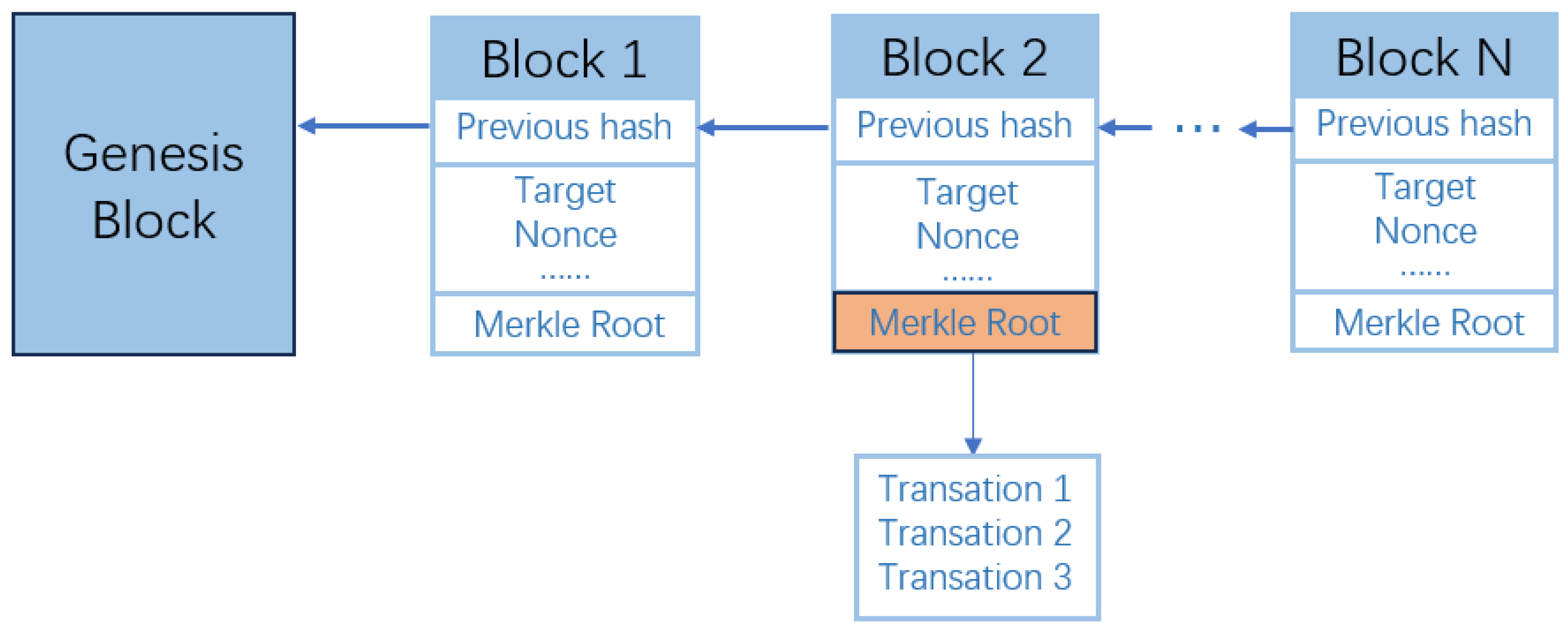
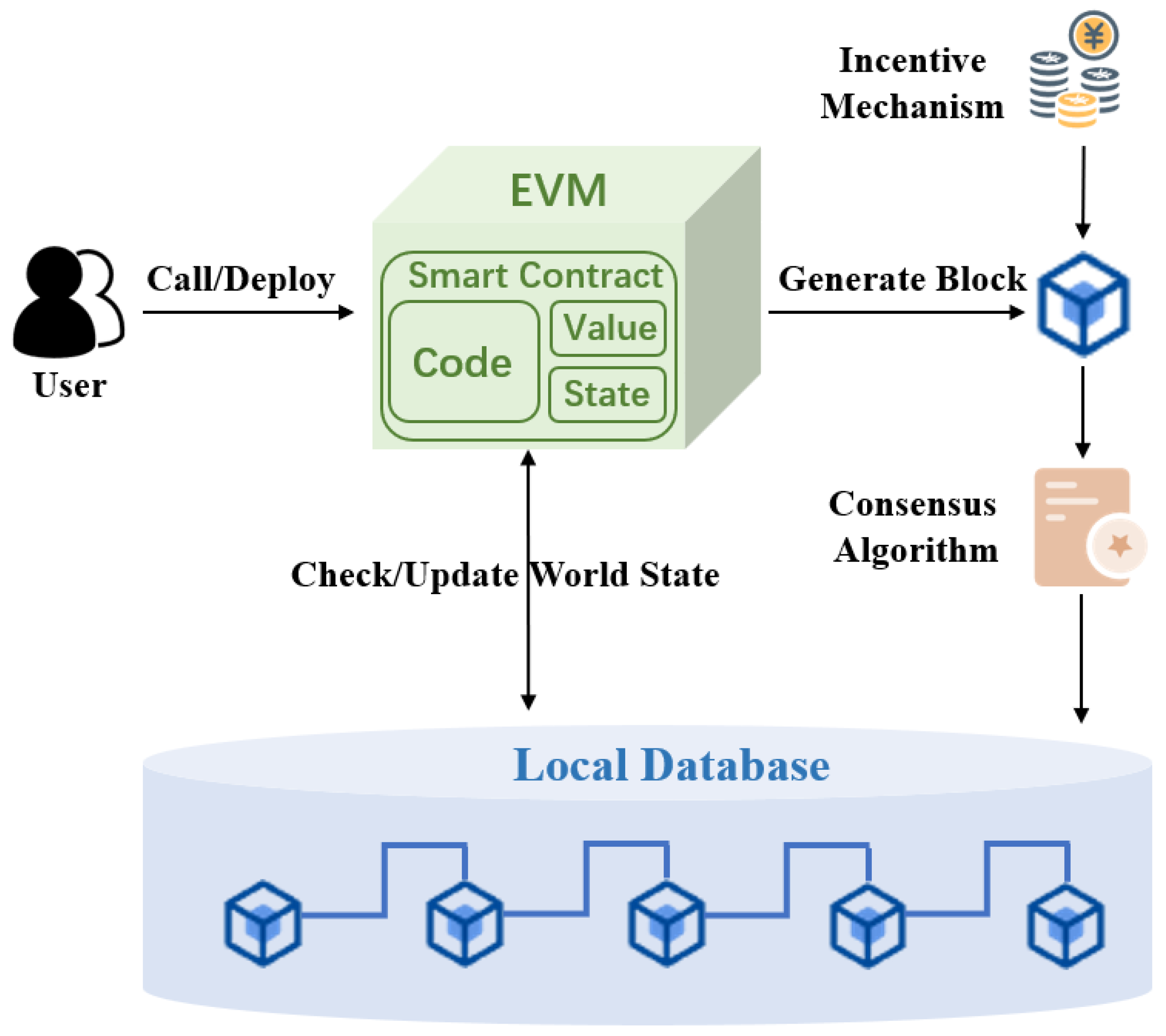




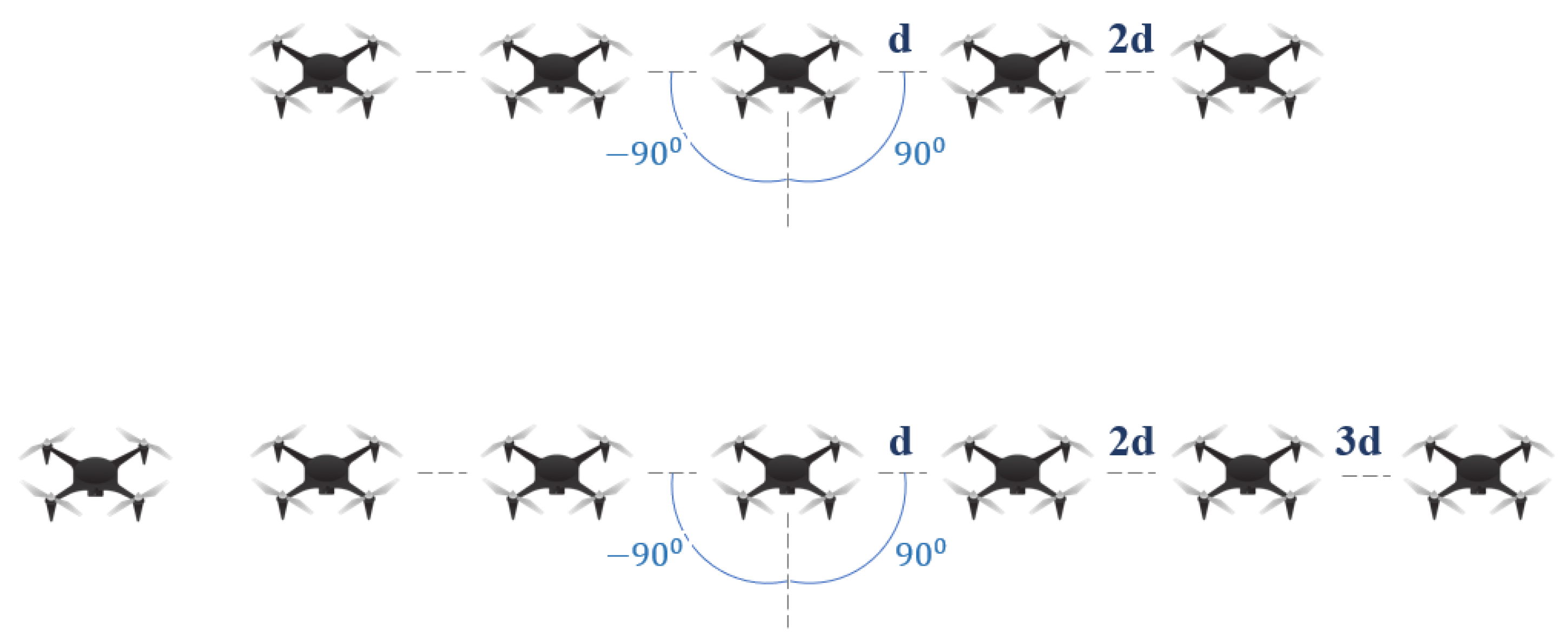

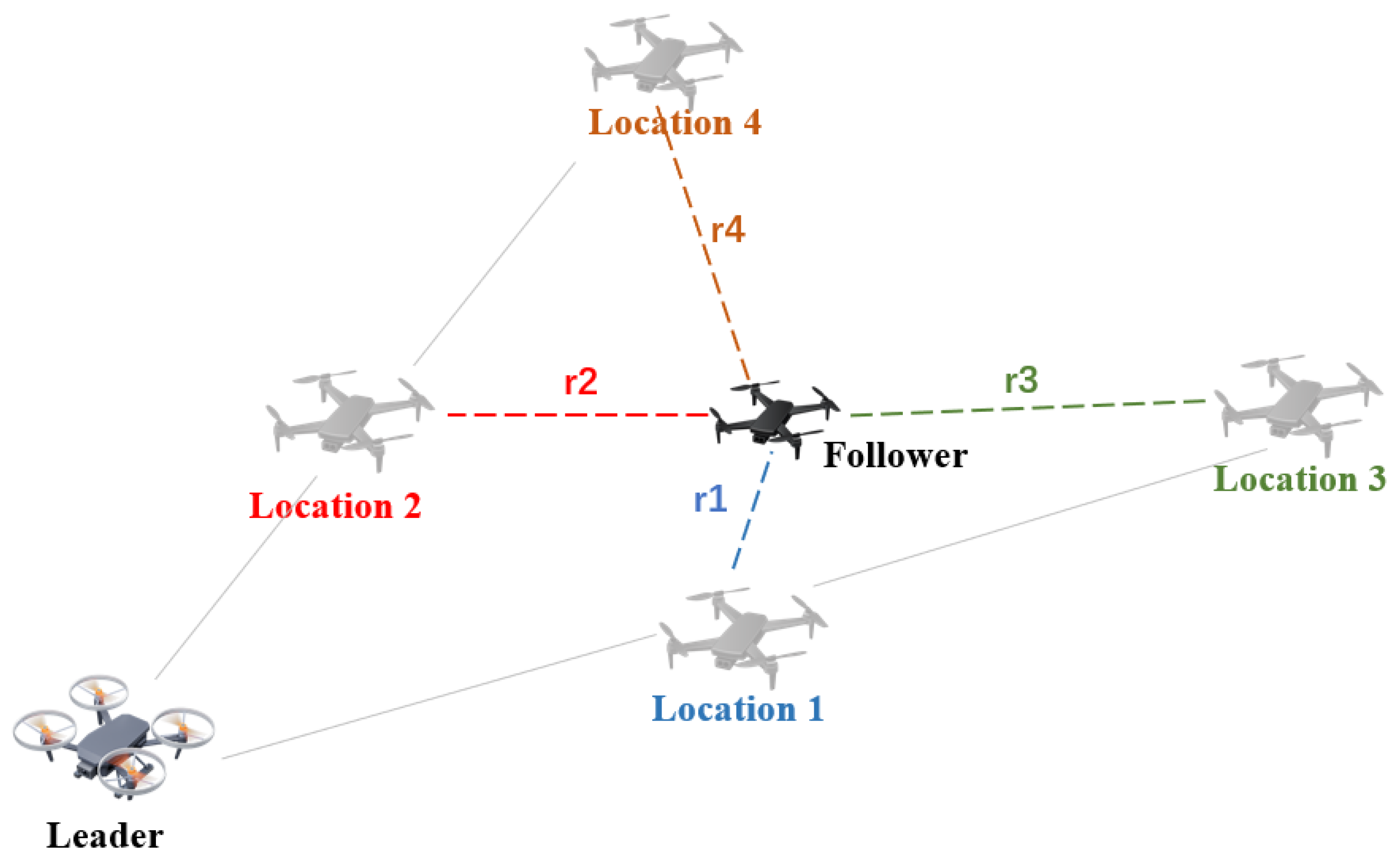
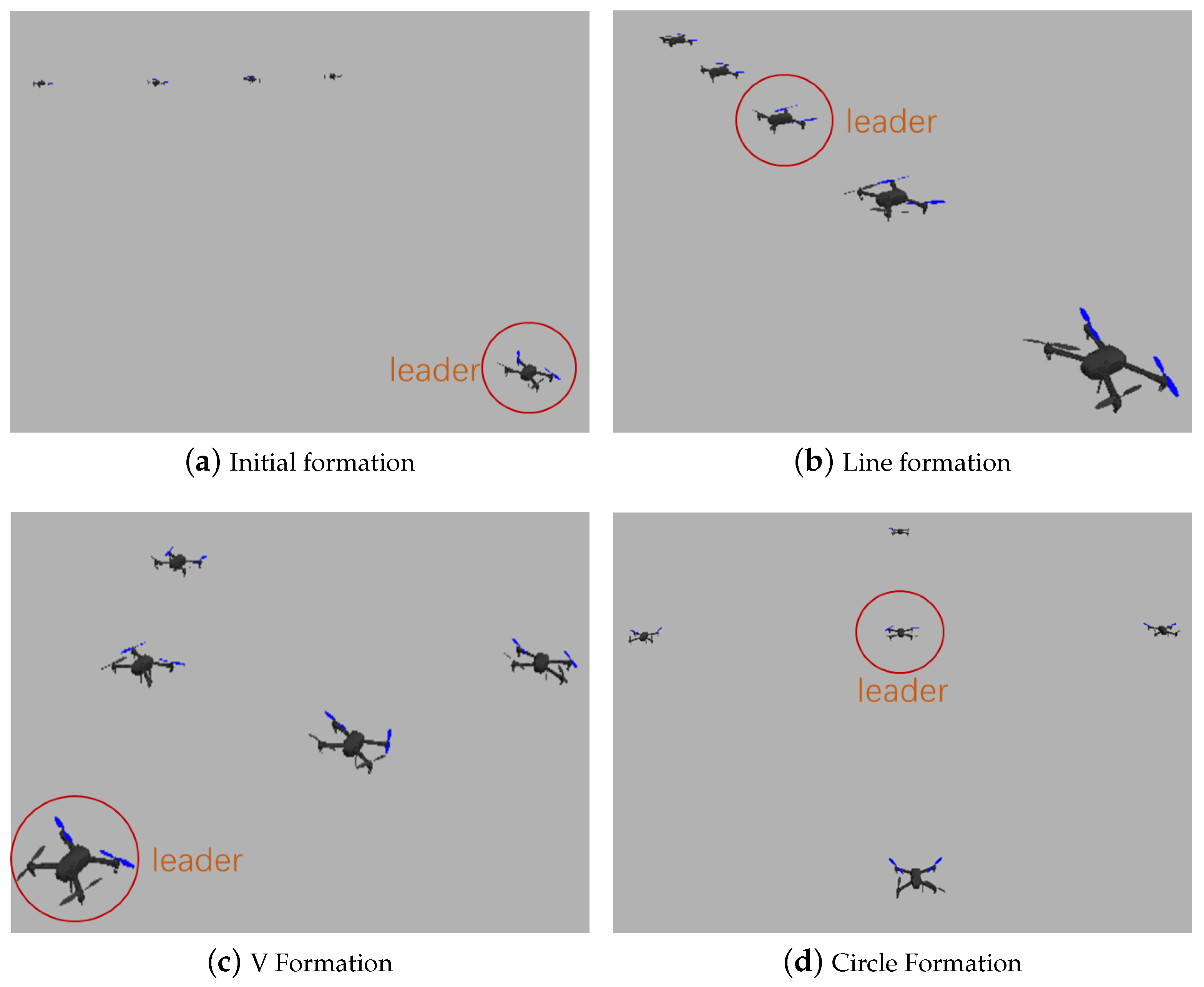
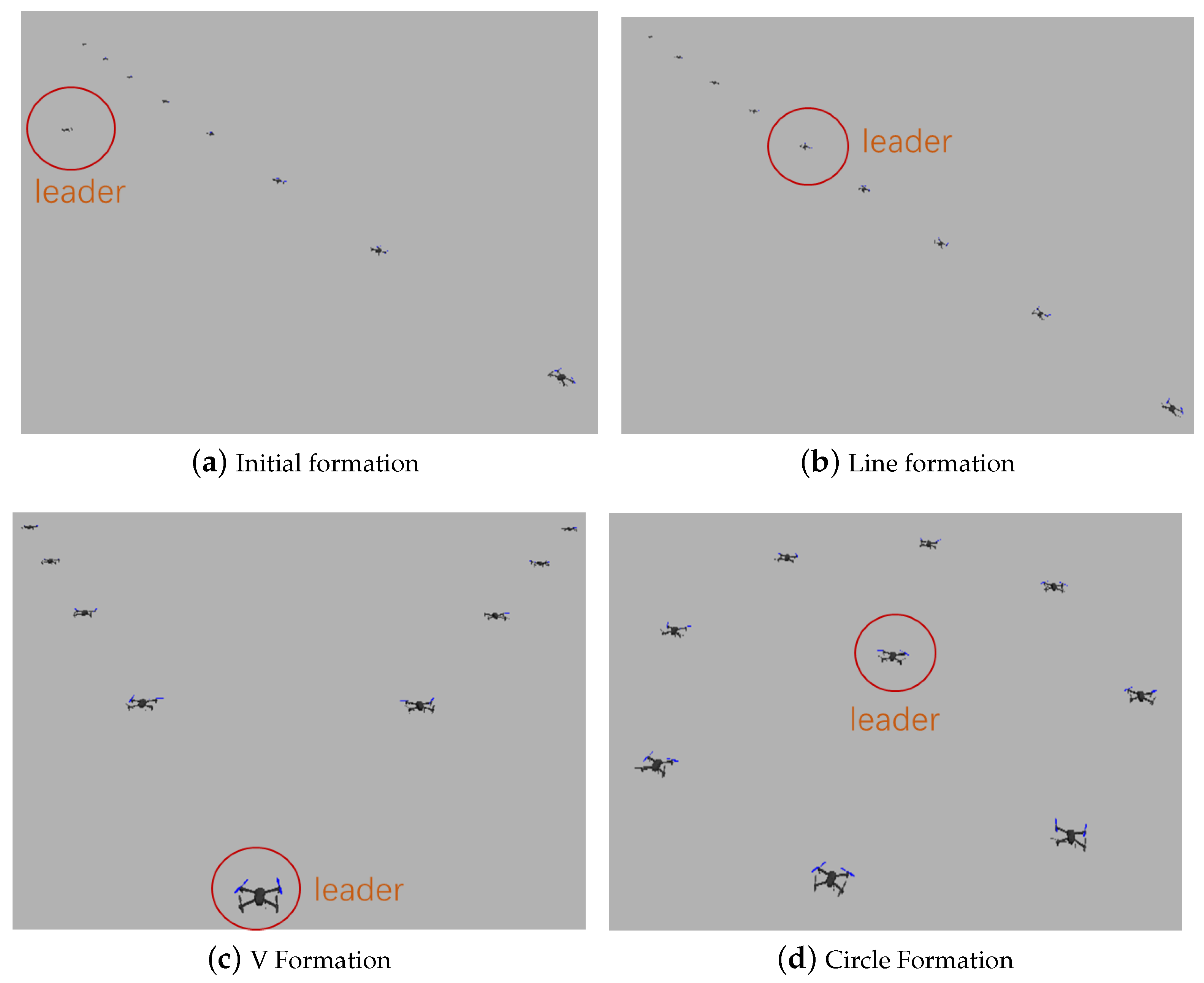

| Control Architecture | Specific Method | Advantages | Disadvantages |
|---|---|---|---|
| Centralized | Leader–Follower |
|
|
| Distributed | Virtual Structure |
|
|
| Behavior-Based |
|
| |
| Artificial Potential Field |
|
| |
| Consensus-Based |
|
| |
| Intelligent Control |
|
|
| Formation Change | 4-UAV Latency (s) | 8-UAV Latency (s) |
|---|---|---|
| 1 | 1.68 | 1.74 |
| 2 | 1.70 | 1.76 |
| 3 | 1.72 | 1.79 |
| 4 | 1.72 | 1.79 |
| 5 | 1.70 | 1.76 |
| 6 | 1.71 | 1.77 |
| 7 | 1.70 | 1.79 |
| 8 | 1.72 | 1.80 |
| 9 | 1.65 | 1.70 |
| 10 | 1.70 | 1.80 |
| Max Latency | 1.72 | 1.80 |
Disclaimer/Publisher’s Note: The statements, opinions and data contained in all publications are solely those of the individual author(s) and contributor(s) and not of MDPI and/or the editor(s). MDPI and/or the editor(s) disclaim responsibility for any injury to people or property resulting from any ideas, methods, instructions or products referred to in the content. |
© 2025 by the authors. Licensee MDPI, Basel, Switzerland. This article is an open access article distributed under the terms and conditions of the Creative Commons Attribution (CC BY) license (https://creativecommons.org/licenses/by/4.0/).
Share and Cite
Li, H.; Li, P.; Liu, J.; Zhang, P. Secure Communication and Dynamic Formation Control of Intelligent Drone Swarms Using Blockchain Technology. Information 2025, 16, 768. https://doi.org/10.3390/info16090768
Li H, Li P, Liu J, Zhang P. Secure Communication and Dynamic Formation Control of Intelligent Drone Swarms Using Blockchain Technology. Information. 2025; 16(9):768. https://doi.org/10.3390/info16090768
Chicago/Turabian StyleLi, Huayu, Peiyan Li, Jing Liu, and Peiying Zhang. 2025. "Secure Communication and Dynamic Formation Control of Intelligent Drone Swarms Using Blockchain Technology" Information 16, no. 9: 768. https://doi.org/10.3390/info16090768
APA StyleLi, H., Li, P., Liu, J., & Zhang, P. (2025). Secure Communication and Dynamic Formation Control of Intelligent Drone Swarms Using Blockchain Technology. Information, 16(9), 768. https://doi.org/10.3390/info16090768






